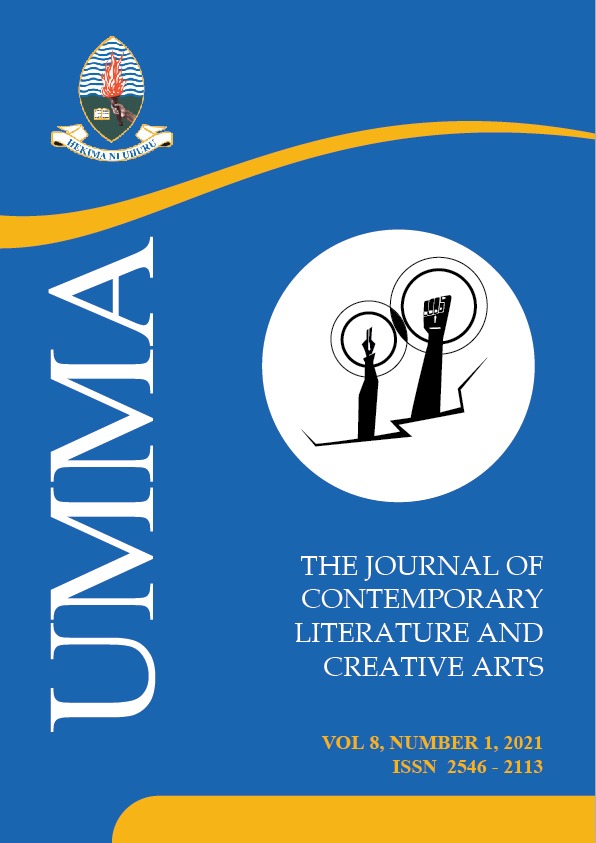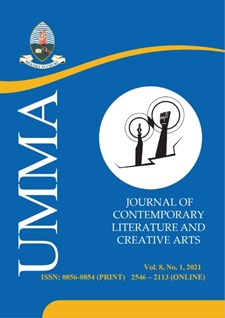Sexism and misogyny in selected proverbs of the Chaga of Machame
Abstract
AbstractThis work employs a feminist perspective to examine how some proverbs of the
Chaga of Machame portray a sexist ideology that supports patriarchal relations as
well as social systems or environments in which women face cultural
stereotyping. It discusses the impressions that some proverbs create and how
such impressions set rules which govern how women are, should be treated and
how they are expected to behave. It has been argued that some life-long gendered
attitudes towards women are evident in the selected proverbs and that they take
part in the creation of a social system which explains how women are seen,
represented and how gender relations are organized, promoted, and shaped. The
paper shows that proverbs constitute a powerful rhetorical device for the shaping
of moral consciousness, opinions, and beliefs.
Key words:
Oral literature, Sexism, Gender studies, Chaga oral art, Proverbs
Introduction
References
Africa. Oxfor: Oxford University Press.
Flax, J. (1987). "Postmodernism and gender relations in feminist theory." in Signs
(4):621-643.
Hangartner-Everts, E. (2008). "Tradition of African story Telling: Oral Literature
in the Homes and Schools (Pre-School, Kindergarten) of Northern Malawi."
Hawley, A. (1970). "A man ' s view" in J. Cooke et.al (eds). The new woman.
Greenwich. Fawcett Premier Book, pp.145-152.
Hussein, J.W. (2005). "The Social and ethno-cultural construction of masculinity
and femininity in African proverbs." in African study monograph 26(2):59-87.
Hussein, J.W. (2009). "A Discursive Representation of Women in Sample Proverbs
from Ethiopia, Sudan and Kenya." in Research in African Literatures 40(3):96-108.
Kiyimba, A. (2005). "Gendering Social Destiny in the Proverbs of the Baganda:
Reflections on Boys and Girls Becoming Men and Women." in Journal of African
Cultural Studies 17 (2): 253-270
Sexism and misogyny in selected proverbs of the Chaga
UMMA, Volume 1, 2020 35
Kweka, E. (2006). "Position of women as reflected in the proverbs of Chagga of
Machame". Unpublished Oral Literature research report, University of Dar es
Salaam, Tanzania.
LaGuardia, D. (2013). Intertextual masculinity in French renaissance literature.UK:
Ashgate Publishing. https://doi.org/10.1093/fs/knp213.
Lema, E.P. (2005). "The Socializing function of proverbs among the Chagga of
Machame". Unpublished Oral Literature report, University of Dar es Salaam,
Tanzania.
Marealle, T. (1997). Historia ya kanisa la kiinjili la Kilutheri Afrika mashariki: 1902-
(Kilimanjaro, Arusha, Meru na Pare). Moshi: Moshi Printing Services.
Mazikana, P. C and Moss, W. (1986). Archives, Oral History and Oral Tradition: A
Ramp Study. Paris: General Information Programme and UNISIST, UNESCO.
Mieder, W. (2008). Proverbs speak louder than words: Wisdom in art, culture, folklore,
history, literature and mass media. York: Peter Lang.
Muro, E.D. (2003). Fyaaso Fya Washaka wa Mashami (Methali za Wachaga wa
Machame). Arusha: Habari Maalumu Press.
Mwaifuge, E.S. (2017). "Patriarchy and social determinism: interrogating feminist
agenda in Tanzania ' s neglected poetry." in Marang: Journal of Language and
Literature 28: 72-89.
Nibafasha, S. (2013). Societal Construction of Masculinity and Femininity as Portrayed
in Kirundi proverbs. M.A dissertation, Makerere University, Uganda.
Nino, L. (2006). "Women, feminism, sexuality and equality in the work place." in
E-leader, Slovakia: pp. 1-7.
Nurse, D.P. (1979). Classification of the Chaga Dialects: Language and History on
Kilimanjaro, the Taita Hills, and the Pare Mountains. Hamburg: Buske.
Omoera, O.S. (2013). "Context of Usage and Aesthetics of Selected Proverbs from
Southern Nigeria." in Journal of Language, Technology & Entrepreneurship in Africa
(1):16-30.
Pyle, W.J. (1976). "Sexism in Children's Literature: Theory into Practice." in The
Early and Middle Childhood Years of Schooling 15(2):116-119.
Rasul, S. (2015). "Gender and Power Relationships in the Language of Proverbs:
Image of a Woman." in FWU Journal of Social Sciences 9(2):53-62.
Emmanuel Penion Lema
UMMA, Volume 1, 2020
Smith, J, (1991), Misogynies: Reflections on myths and malice. New York: Ballantine
Books.
Squires, J and Kemp, S. (1997). Feminisms. [Oxford] New York: Oxford University
Press.
Udoidem, S.I. "The Epistemological Significance of Proverbs: An Africa
Perspective." Présence AfricaÃne 132:126-136.
Webster, S.K. (1982). "Women, Sex, and Marriage in Moroccan Proverbs" in
International Journal of Middle East Studies 14(2):173- 184.
Yankah, K. (1989). "Proverbs: The Aesthetics of Traditional Communication." in
Research in African Literatures 20(3):325-346.
Yitah, H. (2009). "Fighting with Proverbs": Kasena Women's (Re)Definition of
Female Personhood through Proverbial Jesting" in Research in African Literatures
(3): 74-95.
Yusuf, F.Y.K. (1998). "Gender bias and images of women in English and Yoruba
Proverbs: A cross-cultural Approach." in Gender and perceptions and development in
Africa. (Ed) M.E.M Kolawole. AAP.
Downloads
Additional Files
Published
Issue
Section
License
- Authors retain copyright and grant the journal right of first publication with the work simultaneously licensed under a Creative Commons Attribution License that allows others to share the work with an acknowledgement of the work's authorship and initial publication in this journal.
- Authors are able to enter into separate, additional contractual arrangements for the non-exclusive distribution of the journal's published version of the work (e.g., post it to an institutional repository or publish it in a book), with an acknowledgement of its initial publication in this journal.
- Authors are permitted and encouraged to post their work online (e.g., in institutional repositories or on their website) prior to and during the submission process, as it can lead to productive exchanges, as well as earlier and greater citation of published work (See The Effect of Open Access).



